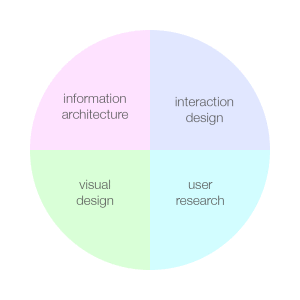
User Experience is everything that affects a user’s behaviour and interaction with a product or service. It’s about how a person feels, understands, and perceives a product.
Many people confuse User Experience with aesthetics of a product. User Experience Design – rather than focusing just on visual or technical aspects, largely deals with the psychology and behaviour of people.
Also, UX is an umbrella term which comprises of four major disciplines:
- Information architecture
- Interaction design
- Visual design
- User research
When someone refers to themselves as UX designers, it usually means they have a good understanding of all the four disciplines and are experts at probably a couple of them. I’m yet to come across someone who is an expert in all the four disciplines.
As in my situation, I have a solid understanding of Information Architecture and User research, but my expertise lies in Interaction and Visual design space.
So what does a UX Designer do?
Depends on (a) what the project requires? and (b) where the UX designer’s strengths lie. Since I’ve got a better grasp on Interaction and Visual design, my core work consists of:
- Field research and competitor analysis
- Discovering pain points and utopia
- Collaborative sketching
- HTML Prototyping
- CSS Styling
- Concept design in Photoshop
- Interactive wireframes
- Information architecture
- User testing (A/B testing, face-to-face)
- Usability analysis
Answering the misconceptions
UX design = Graphic design
User experience is an umbrella term which encompasses four core disciplines (read above). UXD is about identifying a problem and solving it, and as you can imagine – it takes a lot more than graphic design.
Although graphic design is vital to UX, it is only a small piece of the puzzle. UX aims to improve the overall usability and experience of a product, not just its aesthetics.
UX design is all about the users
Although UXD focuses a lot on learning and observing user’s behaviour, its main aim is to bridge the gap between business and consumers. Without understanding users, a business cannot tailor products to suit their target audience.
Involving user experience designers largely improves the product development cycle by getting designers, developers and other stakeholders on a shared path at a very early stage.
UX design is a quick-fix
It’s the same as calling in a property inspector after building a house to check the soil quality.
Involving a UX designer just before the product launch is probably going to open a can of worms rather than fixing last-minute problems quickly.
Ideally, user experience designers should be a part of the project from its inception. Every product (website, apps, software, and iPhone) design needs research, benchmarking, usability analysis and a good understanding of the market and target audience before it is developed.
